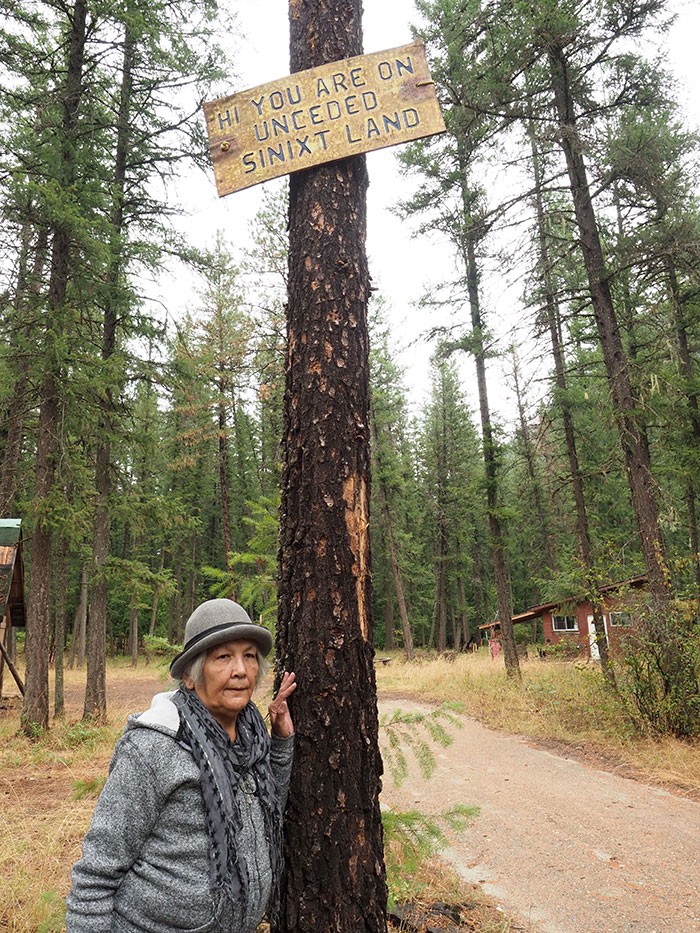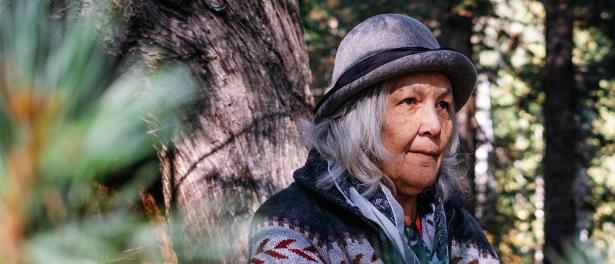“It was like all they cared about was the money,” Tsay Keh Dene Nation member Sylvia Pierre says midway through the documentary DƏNE YI’INJETL — The Scattering of Man. Speaking about BC Hydro — the provincial electrical utility whose dam flooded her nation’s territory — she continues: “They never thought about us as human beings being there, and our needs.”
This failure of colonial powers-that-be to recognize the presence and humanity of Indigenous peoples is a thread woven through both DƏNE YI’INJETL (directed by Luke Gleeson) and Ali Kazimi’s Beyond Extinction: Sinixt Resurgence, two of the five films included in the Landscapes of Resistance spotlight at 2022’s DOXA Documentary Film Festival. The festival’s program describes this collection of films as “rooted in stewardship and grounded in political freedom.” From these roots, Gleeson and Kazimi have grown a pair of films that are equal parts haunting and healing.
The new dam drowned villages, graveyards, animals, and even some people.
DƏNE YI’INJETL recounts how the construction of the WAC Bennett Dam on the Peace River flooded the Tsay Keh Dene Nation off their land, and continues to disrupt the community decades after its completion. Ground was broken on the northeastern BC project — named after the premier who spearheaded its creation — in 1961, and construction finished ahead of schedule in 1968. That process flooded more than 175,000 hectares of the territory of the Tsay Keh Dene (a band of the larger Sekani people). The new dam drowned villages, graveyards, and other culturally significant sites; the animals and natural resources the nation members relied on; and even some people.
The Bennett dam is one of the world’s largest earth-filled structures, and its GM Shrum Generating Station currently creates nearly a quarter of BC Hydro’s total hydroelectricity. Yet the Tsay Keh Dene Nation doesn’t “benefit” from it: the power the dam generates is all sent south, so the Tsay Keh Dene community to its north is instead powered entirely by diesel.
The film weaves together archival footage — of dam construction and the displacement of the Tsay Keh Dene — with present-day interviews of the nation’s members, juxtaposing the harrowing details of members’ personal and communal losses with imagery of machines ushering in “progress” and prosperity for the surrounding colonial society.

Artificial beaches near the WAC Bennett Dam cause dust storms that plague the displaced Tsay Keh Dene Nation. (Photo courtesy the Tsay Keh Dene Nation)
DƏNE YI’INJETL is told in three acts. Each act begins with a snippet of a Sekani story narrated by Tsay Keh Dene member Bob Pierre, about a man named Tsawəya and his persistence in the face of centuries of attempts to slay him by Old Man (a character Pierre describes as an “ancient creature”). Here, Old Man has an obvious parallel in the federal and provincial governments, and subsidiaries like BC Hydro. This structure, the film’s emotional original score, and sweeping landscape shots all make for evocative cinema.
The force behind it all is Tsay Keh Dene musician and filmmaker Gleeson. In an interview, Gleeson said he proposed the documentary to the Nation in 2014, after the community had been approached by BC Hydro about featuring in some informational short films about the dam. The Tsay Keh Dene declined.
“We just felt that it was inappropriate for us to participate in that, since we still are dealing with a lot of the impacts,” explained Gleeson. Ongoing impacts include trees drowned by the reservoir that float to the surface and endanger boats, and poor air quality resulting from dust storms that occur on the artificial beaches around the dam. “The elders… told me that they were ready to tell their story, but we wanted to do it on our own terms.”
The elders told me they were ready to tell their story, but we wanted to do it on our own terms.
And DƏNE YI’INJETL accomplishes exactly that. It is a film about the Tsay Keh Dene, by the Tsay Keh Dene, that unflinchingly explains how colonial greed and apathy destroyed their land, loved ones, and way of life, and emphasizes how the nation has resisted that destruction. For instance, the Tsay Keh Dene collect and burn the logs as part of a debris management contract they were awarded by BC Hydro. They irrigate the beaches to curb the dust storms. And members continue to pass down their language, culture, and knowledge to their kids, to maintain the nation’s presence on their land for generations.
“This is our stomping ground,” says Tsay Keh Dene member Rita McIsaac a third of the way into the film, “and this is where we’re going to be buried.”
Ali Kazimi’s Beyond Extinction explores similar themes of Indigenous resilience and revitalisation. In 1995, filmmaker, author, and media artist Kazimi visited the Slocan Valley in southeastern BC for four days. He intended to document the court case of Robert Watt, a Sinixt man facing deportation from Canada due to being born on Sinixt land south of the colonial US-Canada border.

“My vision and my dream is that my grandkids will remember these stories, these places,” says James. (Photo by Ali Kazimi)
The documentary Kazimi hoped to make at the time did not get funded, but Kazimi kept his tapes of interviews with Sinixt elders and footage of them cooking, laughing, and bonding. He also stayed in touch with people he had met, including Nation spokesperson Marilyn James, and Watt’s lawyer Zool Suleman. In 2019, Kazimi won the Governor General’s Award for Visual and Media Arts, and decided to use the C$25,000 prize to continue his unfinished project.
The resulting film documents the Sinixt’s nearly three-decades-long struggle to be recognized by the Government of Canada after being declared legally “extinct” in 1956. A significant portion of the Sinixt were pushed off their land and forced to move south of the border, where the US government eventually resettled them onto a reservation along with members of 11 other Indigenous groups. The Sinixt population remaining in Canada were incorporated into the Arrow Lakes Indian Band, and members in the US were prevented from accessing their traditional territory by the Government of Canada.
When the last registered member of the Arrow Lakes Band died in 1953, Canada declared the Sinixt “extinct.” A Supreme Court of Canada ruling from 2021 included the assertion that the nation is not in fact “extinct,” but this judgment has yet to result in the kind of recognition James is seeking from the Government of Canada.
Beyond Extinction exudes hope by offering a glimpse of the Sinixt Nation’s persistence in the face of erasure.
The film stitches Kazimi’s original footage together with new footage of his from 2019, and archival fragments sourced from others. Lingering shots of the lush Slocan Valley, old and recent interviews with James, Suleman, and Sinixt matriarchs, and intimate footage of the Sinixt community nurturing their traditions and territory combine into a film that enlightens and inspires action.
Beyond Extinction unpacks the disastrous consequences of centuries of ongoing, intentional genocide on the Sinixt Nation — alongside numerous Indigenous groups across Canada (and the US). It asks its audience to re-examine their own complicity in this colonial project, and exudes hope by offering a glimpse of the Sinixt Nation’s persistence in the face of erasure.
“My vision and my dream is that my grandkids will remember these stories, these places,” says James, toward the end of Beyond Extinction. “They’ll honour them, they’ll respect them.” Thanks to her efforts, viewers of Beyond Extinction have every reason to believe they will.
Vancouver’s DOXA Documentary Film Festival runs from May 5–15, 2022. DƏNE YI’INJETL — The Scattering of Man (75 min, English and Sekani with English subtitles) screens in person on May 7 at 4:45 pm, at the VIFF Centre, and on May 9 at 6:15 pm, at The Cinematheque. Beyond Extinction: Sinixt Resurgence (98 min, English) screens in person on May 7 at 2 pm, at the VIFF Centre, and on May 9 at 4 pm at the Djavad Mowafaghian Cinema. The films can also be screened virtually from anywhere in Canada throughout the festival. Tickets to in-person and online screenings are available on the DOXA website.
Zeahaa (pronounced Zaha) Rehman is a Pakistani-Canadian freelance journalist whose work has been published in The Local, The Walrus, Chatelaine, and more.
Like this story? With a one-time or monthly donation, you can help Asparagus continue publishing the large and small stories of sustainability.
If donating isn’t in the cards today, you can support our efforts by sharing this story, and, if you’re a Medium member, giving it some enthusiastic claps. (If you’re not a member, why not join and follow Asparagus, or sign up for our e-mail newsletter? That way you’ll never miss a story.)


Spread the word